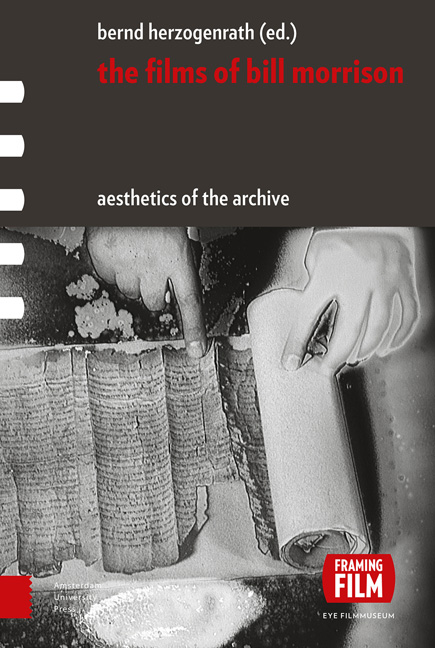Book contents
- Frontmatter
- Contents
- Acknowledgments
- Aesthetics of the Archive: An Introduction
- Chapter 1 Drafts and Fragments: Reflections around Bill Morrison and the Paper Print Collection
- Chapter 2 The Film of Her: The Cine-Poet Laureate of Orphan Films
- Chapter 3 Ghost Trip: Searching for Potential Myths
- Chapter 4 Decasia: The Matter | Image: Film is also a Thing
- Chapter 5 The Mesmerist: Illustrating the Return of the Repressed
- Chapter 6 Light is Calling: Celluloid Dreams
- Chapter 7 Gotham: Zoetrope: Block by Block
- Chapter 8 Outerborough: Early Cinema Revisited
- Chapter 9 The Highwater Trilogy: Thinking the Liquid – On the Ethics of Water and the Material Ecologies of Disaster and Ruination
- Chapter 10 Porch: Archives, Collective Memory, and the Poetics of Home Movies
- Chapter 11 The Future Lasts Long: The Romanov Lost Family Archives
- Chapter 12 Who by Water: Variations on Matter, Figures, Memory, and Mythology
- Chapter 13 Every Stop on the F-Train: Beyond and within the Restless Netherworld of (Manhattan’s) Mind
- Chapter 14 Spark of Being: Bachelor Machine
- Chapter 15 The Miners’ Hymns: Acts of Resurrection
- Chapter 16 Tributes – Pulse: A Requiem for the 20th Century: Death | Drive | Image
- Chapter 17 Just Ancient Loops: The Loops of Life in Intonation
- Chapter 18 The Great Flood: Water is Transparence Derived from the Presence of Everything
- Chapter 19 Re-Awakenings: Bill Morrison in Conversation
- Index of Film Titles
- Index of Names
- Index of Subjects
- Already Published
Chapter 6 - Light is Calling: Celluloid Dreams
Published online by Cambridge University Press: 12 December 2020
- Frontmatter
- Contents
- Acknowledgments
- Aesthetics of the Archive: An Introduction
- Chapter 1 Drafts and Fragments: Reflections around Bill Morrison and the Paper Print Collection
- Chapter 2 The Film of Her: The Cine-Poet Laureate of Orphan Films
- Chapter 3 Ghost Trip: Searching for Potential Myths
- Chapter 4 Decasia: The Matter | Image: Film is also a Thing
- Chapter 5 The Mesmerist: Illustrating the Return of the Repressed
- Chapter 6 Light is Calling: Celluloid Dreams
- Chapter 7 Gotham: Zoetrope: Block by Block
- Chapter 8 Outerborough: Early Cinema Revisited
- Chapter 9 The Highwater Trilogy: Thinking the Liquid – On the Ethics of Water and the Material Ecologies of Disaster and Ruination
- Chapter 10 Porch: Archives, Collective Memory, and the Poetics of Home Movies
- Chapter 11 The Future Lasts Long: The Romanov Lost Family Archives
- Chapter 12 Who by Water: Variations on Matter, Figures, Memory, and Mythology
- Chapter 13 Every Stop on the F-Train: Beyond and within the Restless Netherworld of (Manhattan’s) Mind
- Chapter 14 Spark of Being: Bachelor Machine
- Chapter 15 The Miners’ Hymns: Acts of Resurrection
- Chapter 16 Tributes – Pulse: A Requiem for the 20th Century: Death | Drive | Image
- Chapter 17 Just Ancient Loops: The Loops of Life in Intonation
- Chapter 18 The Great Flood: Water is Transparence Derived from the Presence of Everything
- Chapter 19 Re-Awakenings: Bill Morrison in Conversation
- Index of Film Titles
- Index of Names
- Index of Subjects
- Already Published
Summary
ABSTRACT
Like all films, the films of Bill Morrison rely on two main media. On the one hand, the specific film stock that carries the images, on the other, the light that makes the images possible in the first place and thus, albeit in a different manner, might also be said to ‘carry’ the images.
This essay attempts to set up a more complex relation between these various forms of media. Drawing on scientific, philosophical, and artistic theories of light and mediality, such as those of Fritz Heider, Gilles Deleuze, and Niklas Luhman, this essay not only develops the notion of ‘media milieus’, but address the technologics, the aesthetics, and the poetics of Morrison's movie.
KEYWORDS
celluloid, light, luminosity, medium
The relationship between thought and life is analogous to the relationship between a structured technical object and the natural environment.
– Gilbert SimondonA SIMPLE CASE OF RUIN PORN?
Upon first watching Bill Morrison's movie Light is Calling, one might get the impression that it is simply another case of ruin porn, which is the name recently given to the artistic celebration of dilapidation, material distress and decay, created from within a highly aestheticized, neo-gothic sensibility that operates in registers of spectacular necrophilia often felt to show a deeply fetishistic relation to monuments and moments of obsolescence.
One might wonder whether calling the recent delight in ruins pornographic is a result of an excess of political correctness or whether its optical gloss concerns more the nostalgic erotics of obsolescence than its pornographic display. Perhaps it is the softcore dreamspace of material culture studies. Whatever the judgement on this debate, the question is whether Light Is Calling is just another tableau of abandonment and disrepair. Should one read it as a celluloid disaster that showcases and celebrates the derelict poetry of an old, materially deteriorated, and optically degraded celluloid movie reel? Does its aesthetic effect exhaust itself in the documentary delight in the beauty of an optical ruin? Is its mesmerizing visual appeal simply the result of the inherent poetry of processes of celluloid decay?
CELLULOID DREAMS
Movies are sometimes called celluloid dreams in the sense that they project, by way of the silver screen, a culture's collective beliefs, hopes, and aspirations into that culture's communal imaginary.
- Type
- Chapter
- Information
- The Films of Bill MorrisonAesthetics of the Archive, pp. 109 - 122Publisher: Amsterdam University PressPrint publication year: 2017



